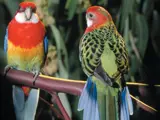 Eastern rosella
Eastern rosella
Common name: Eastern rosella
Botanical name: Platycercus eximius
Management programme: Advisory
Where are they originally from?
Originally from Australia. They were first introduced into New Zealand in the early 1900s, likely from cage escapees and/or intentional releases.
Why are they a pest?
- Damage to grain and fruit crops.
- Competition with native bird species.
- Potential to spread avian diseases.
Where are they found?
Mainly seen in open, partially wooded landscapes including urban parks, gardens, golf courses, farmland, orchards, wetlands and stands of exotic and native trees. They use the edges of extensive native forest areas more than the interior.
What do they look like?
- Brightly coloured parrot with a distinctive red head, with white cheek patches.
- The red extends down the chest and forms a ‘bib’ giving way to a yellow body.
- The upper back is yellow to green, with black patches in the centre of each feather.
- The rump is often bright green, often observed when they are flying.
What are the rules?
Advisory
Council does not enforce the control of advisory species. It is landowner/occupier responsibility to manage these pests. Council may provide advice on how to manage or control advisory species if required.
How do you get rid them?
- Shooting – only likely to be effective on small number of birds.
- Cage traps – unproven at this stage.
- Alphachloralose Narcotic.
Professional pest controllers are recommended.
CAUTION: When using Alphachloralose, please READ THE LABEL thoroughly to ensure that all instructions and safety requirements are followed. All firearms laws MUST be adhered to when using a firearm. When using traps please ensure that all instructions, safety requirements and laws (in particular the Animal Welfare Act 1999) are followed.
NAWAC (National Animal Welfare Advisory Committee) approved kill traps need to be set as per the manufacturers guidelines.
Guidelines on trap use https://www.mpi.govt.nz/animals/animal-welfare/animal-welfare-and-pest-management/traps-and-devices/
DISCLAIMER: Information in this fact sheet regarding the narcotic Alphacloralose does not necessarily appear on the labels of the products concerned. Bay of Plenty Regional Council does not accept liability for any damage that may arise from the use of Alphachloralose at non-standard rates. Mention of product trade names implies neither endorsement of those products nor criticism of similar products not mentioned. Bay of Plenty Regional Council does not accept liability for any damage or injury that may arise from the use of traps, toxins and firearms.
Read more on pest control guidelines and regulations
Images

